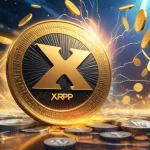Ripple Lands $500M at $40B Valuation, Forging Crypto-TradFi Powerhouse

Ripple Secures $500M Investment at $40B Valuation, Bridging Crypto and TradFi
Ripple has clinched a massive $500 million strategic investment round at a towering $40 billion valuation, with powerhouse financial firms like Fortress Investment Group and Citadel Securities leading the way. Backed by crypto-native heavyweights such as Pantera Capital and Galaxy Digital, this funding signals unshakeable confidence in Ripple’s mission to fuse traditional finance (TradFi) with digital assets, even as it wrestles with regulatory shadows and fierce market competition.
- Historic Funding: $500 million raised at a $40 billion valuation, led by Fortress and Citadel affiliates.
- Aggressive Growth: Six acquisitions in two years, including Rail, GTreasury, and Ripple Prime, expanding its financial toolkit.
- Regulatory Traction: 75 global licenses and stablecoin clarity via the GENIUS Act propel RLUSD past a $1 billion market cap.
TradFi Titans Place a Big Bet on Ripple
This isn’t just another funding round; it’s a seismic shift in how Wall Street views blockchain tech. Fortress Investment Group, a juggernaut managing over $48 billion in assets with deep roots in real estate and credit markets, and Citadel Securities, a market-making behemoth processing trillions in trades annually, aren’t your typical crypto cheerleaders. Their involvement screams calculated trust—likely driven by a need to hedge against fintech disruption and gain early exposure to blockchain’s potential to overhaul global finance. Add in crypto-savvy backers like Pantera Capital, Galaxy Digital, Brevan Howard, and Marshall Wace, and Ripple has assembled a dream team spanning old money and new tech. This follows a $1 billion tender offer earlier in 2025 at the same valuation, alongside a 25% share repurchase to reward early employees and shareholders with liquidity. For more details on this historic investment, check out the announcement of Ripple’s $500M funding round.
Ripple’s CEO, Brad Garlinghouse, didn’t mince words about the significance of this milestone. “This investment reflects both Ripple’s incredible momentum and further validation of the market opportunity we’re aggressively pursuing,” he declared. He’s got the receipts to back that up. Since its inception in 2012, Ripple has evolved from a niche player in cross-border payments using its native token XRP to a multifaceted beast. As Garlinghouse put it, “We started in 2012 with one use case—payments—and have since expanded that success into custody, stablecoins, prime brokerage, and corporate treasury, leveraging digital assets like XRP.”
Acquisitions Building a Financial Powerhouse
Ripple isn’t just sitting on its laurels—or its cash. It’s on a buying spree, snapping up six companies in just over two years, with two deals clocking in at over $1 billion each. Think of Ripple as assembling a financial Swiss Army knife, each acquisition adding a new blade to tackle a different corner of the market. Let’s unpack a few key moves.
First, there’s Rail, a stablecoin infrastructure provider now woven into Ripple Payments, enhancing its ability to offer digital currencies pegged to stable assets like the U.S. dollar. Then, GTreasury, acquired in October 2025, manages trillions in transactions for Fortune 500 companies. By integrating stablecoins, Ripple is helping these corporate giants access funds around the clock, bypassing the sluggish timelines of traditional banking. And Hidden Road, rebranded as Ripple Prime, caters to institutional players—think big banks and hedge funds—with trading and financing solutions. Since the acquisition, Ripple Prime’s client deposits have doubled, daily transactions have rocketed past 60 million, and platform size has tripled. Meanwhile, Ripple Payments itself has processed over $95 billion in transactions, proving enterprise adoption isn’t just a buzzword—it’s a reality.
For those newer to the space, let’s break down some basics. XRP is Ripple’s native cryptocurrency, built for lightning-fast, low-cost transactions, often used to zip money across borders without the hefty fees or delays of systems like SWIFT (a global banking network). RLUSD, Ripple’s stablecoin, is tied to the U.S. dollar to avoid the wild price swings of tokens like Bitcoin, making it perfect for steady uses like corporate settlements. Ripple Payments is the engine behind these borderless transfers, using blockchain—a decentralized digital ledger—for speed and transparency. Ripple Prime, on the other hand, is like a VIP trading desk for institutional whales, offering tailored financial services.
Regulatory Wins and Stablecoin Surge
A major tailwind for Ripple is the regulatory clarity starting to emerge. Holding 75 licenses worldwide, Ripple has permission to operate legally across numerous jurisdictions, smoothing the path for moving client funds and managing liquidity. Why does this matter? In crypto, a single misstep can spark lawsuits or outright bans, so these licenses build trust with cautious institutions. The GENIUS Act, passed in the U.S. in 2025, further clears the fog around stablecoins, defining how they’re regulated and giving businesses confidence to adopt tools like RLUSD. The result? RLUSD soared past a $1 billion market cap in under a year, becoming a go-to for treasury and settlement needs.
But it’s not all smooth sailing globally. While the U.S. takes steps forward, the European Union’s Markets in Crypto-Assets (MiCA) framework imposes strict compliance costs that could slow expansion. In Asia, regulatory approaches vary wildly—Singapore welcomes innovation, while China remains a hard no. Ripple’s global footprint means navigating this patchwork of rules is a constant chess game, even with its licensing arsenal.
The SEC Elephant in the Room
Let’s address the gorilla in the corner—Ripple’s long-running clash with the U.S. Securities and Exchange Commission (SEC). The agency has argued since 2020 that XRP might be an unregistered security, a classification that could slap Ripple with fines or operational limits. As of 2025, while a final resolution remains unclear, partial court rulings have leaned in Ripple’s favor, suggesting XRP sales on exchanges aren’t securities. Still, the uncertainty lingers like a bad hangover. This $500 million infusion, alongside the share repurchase, could be Ripple’s way of padding its war chest for legal fees or potential penalties. If the SEC tightens the screws, that lofty $40 billion valuation might start looking wobbly—investors hate unpredictability more than a bear market.
Risks and Competitive Heat
Before we crown Ripple the king of crypto finance, let’s pump the brakes. That $40 billion valuation is a shiny trophy, but trophies get heavy when the market sours. If crypto winter returns or regulators flip-flop, Ripple could face a brutal reality check. And the competition? It’s cutthroat. In the stablecoin arena, Tether (USDT) dominates with a market cap exceeding $100 billion, while Circle’s USDC boasts deep integration with DeFi protocols. Both have first-mover advantages and liquidity pools Ripple can only dream of matching overnight. In cross-border payments, Ripple Payments faces rivals too—Stellar’s blockchain offers similar speed, and even Bitcoin’s Lightning Network, though niche, provides a decentralized alternative for microtransactions.
Then there’s the ideological rub. Ripple’s cozy partnerships with TradFi giants might win boardroom applause, but they risk alienating the crypto purists who see Wall Street as the enemy. For Bitcoin maximalists, XRP’s centralized design—where Ripple controls much of the supply and infrastructure—is borderline heretical. Sure, Ripple isn’t trying to be Bitcoin; it’s aiming to be the pipes for a hybrid financial system. But if it leans too hard into TradFi’s embrace, could it lose the rebellious spirit that fuels blockchain’s appeal? That’s a tightrope walk worth watching.
Ripple’s Role in Accelerating Crypto Adoption
Despite the hurdles, Ripple’s hustle can’t be ignored. Pushing blockchain into corporate treasuries and institutional trading isn’t just smart—it’s a form of effective accelerationism, speeding up the shift to decentralized systems even if Ripple’s model isn’t fully aligned with the cypherpunk ethos. The $95 billion in transaction volume on Ripple Payments shows real-world impact. RLUSD’s rapid rise proves stablecoins can outmaneuver clunky financial tools. And by dragging Fortune 500 firms into the digital asset fold via GTreasury, Ripple is laying bricks for a future where blockchain isn’t fringe—it’s foundational.
Yet, the game’s far from won. Ripple’s half-billion-dollar war chest and TradFi backing give it muscle, but in a space where innovation and regulation duke it out daily, even giants can stumble. For now, Ripple is swinging hard, positioning itself as the bridge between yesterday’s banks and tomorrow’s decentralized world. Whether that bridge holds under pressure is the billion-dollar question.
Key Questions and Takeaways
- What does Ripple’s $500 million investment mean for its standing in finance?
It’s a resounding vote of confidence from TradFi leaders like Fortress and Citadel, marking Ripple as a credible link between traditional and digital finance. - How are Ripple’s acquisitions shaping its crypto market dominance?
Deals like Rail, GTreasury, and Ripple Prime expand its reach into stablecoins, corporate cash management, and institutional trading, making it a versatile contender. - Will regulatory progress sustain Ripple’s stablecoin growth with RLUSD?
The GENIUS Act in the U.S. has fueled RLUSD’s $1 billion market cap, but global regulatory inconsistencies could still pose challenges. - What risks threaten Ripple’s $40 billion valuation?
Market downturns, intensified competition from Tether and USDC, and unresolved SEC disputes over XRP could undermine that staggering figure. - Does Ripple’s strategy support broader decentralization goals?
Partially—it accelerates blockchain adoption in mainstream finance, but its centralized elements and TradFi ties may clash with pure decentralization ideals.



